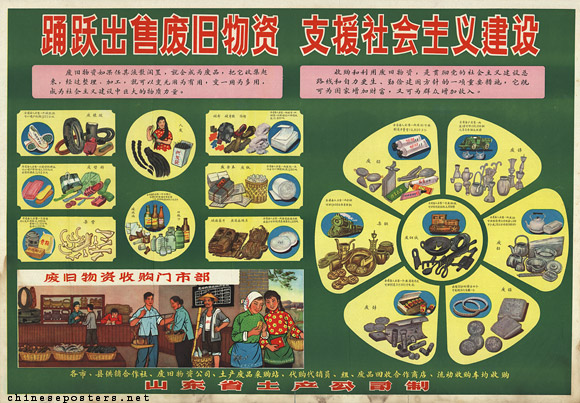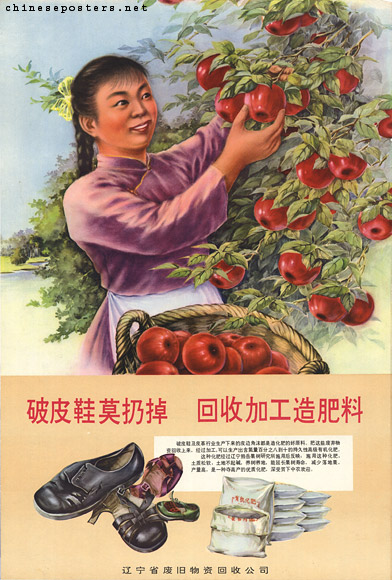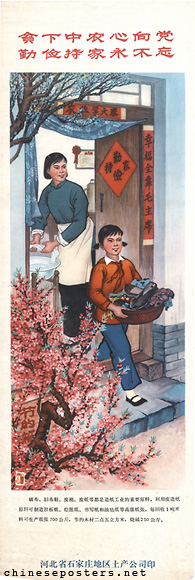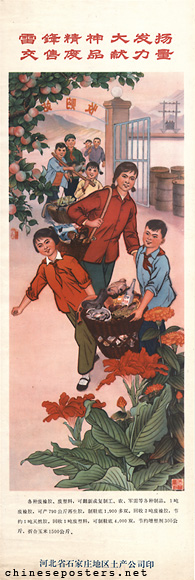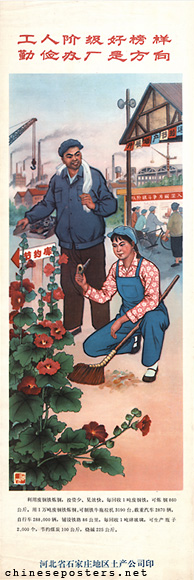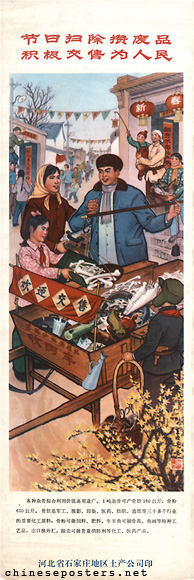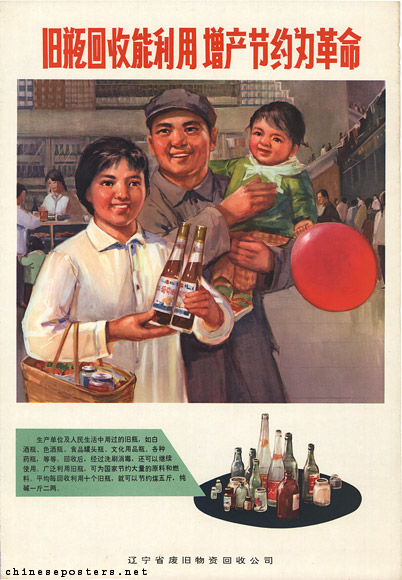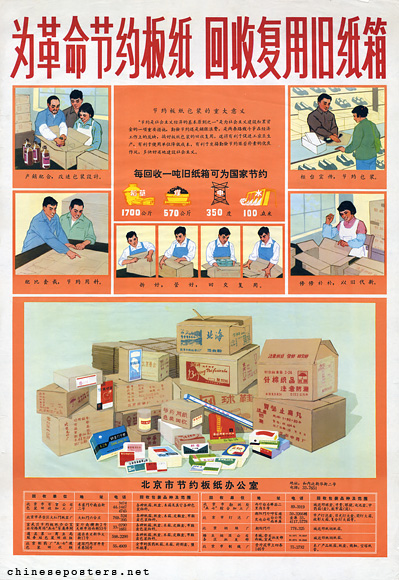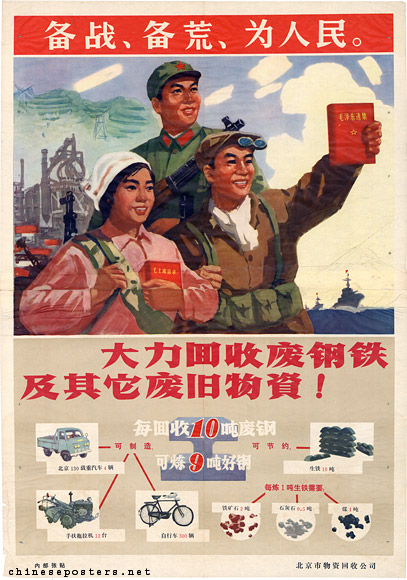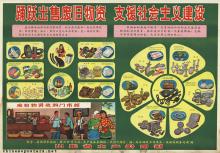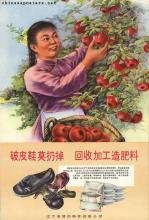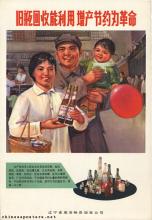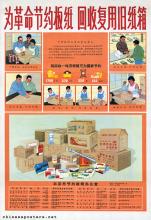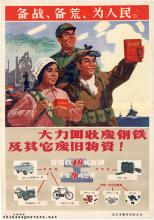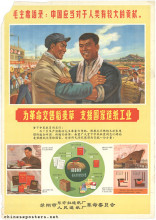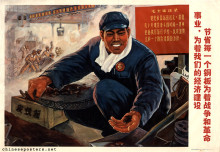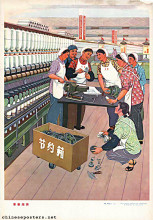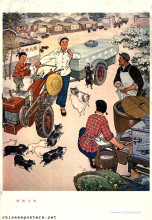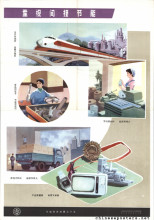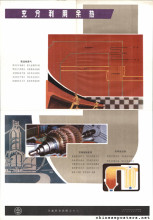Eagerly sell old and useless materials to support the construction of socialism, Early 1960s
Separation and recycling of garbage are becoming mandatory in urban China, but these activities are no new phenomena. The country has a long history of recycling goods. Historian Frank Dikötter once wrote that 'everything was constantly recycled in a culture of thrift and poverty'. Frugality and thrift were part of the Confucian discourse that prevailed in a society of scarcity. It advocated a self-sufficient economy and considered wasteful habits as part of a guilty lifestyle. Every material object could be turned into a commodity, and every commodity could be used and reused endlessly. Goods that no longer could be recycled disintegrated, having been made from organic materials. Even human faeces and excrement were collected, mixed with food waste and other organic leftovers, and then dried and processed into fertilizer for use in the fields.
With the formal establishment of the People’s Republic of China (PRC) on 1 October 1949, the newly installed government under the CCP immediately started to restore unified control over the country after the period of disruption that had lasted for almost 20 years. Orderly urban management was high on the agenda of the national and municipal administrations. The initiatives to return urban society to a more ordered state included a restoration of sanitation services. In Beijing, two highly complex bureaucracies emerged from the early 1950s onward, one for the collection and disposal of household garbage, the other for buying and collecting recyclables and preparing them for processing. The purpose was to salvage as many resources as possible for national construction and industrialization. The recyclables were collected systematically, from individuals to neighbourhood redemption stations and networks, to larger district centres and finally to regional recovery stations. Its organizational structure became a model that was copied on a national scale. The Beijing Municipal Scrap Recycling Company was formed in 1956; it was made up of the more than 7.000 informal collectors, peddlers and hawkers who had plied their trades before. By joining the Company, the scrap collectors attained an elevated position, becoming state workers, with a national responsibility. The Company also operated the collection points that dotted the neighbourhoods, and the stalls for selling goods that could not be reused anymore. In other cities, following the Beijing model, similar official redemption depots were set up in nearly every city block. The collected industrial materials were transported directly to the factories for recycling, eliminating the intermediate levels of the larger collection points and scrap markets. Scrap collecting on this scale was transformed into an important component of the industrial sector.
Don't throw away broken leather shoes, recycle them to turn them into fertilizer, Early 1960s
Campaigns
The administrative focus on the collecting and repurposing of scrap coincided with the national drives to eliminate rats, fleas and flies organized by the Ministry of Health. These campaign targets, which included setting up a garbage removal system, all were part of the first Patriotic Hygiene Campaign in 1952, in which cleanliness was directly linked with health and modernity. The Hygiene Campaign and the many similar ones that unfolded in later years, additionally disciplined the citizens. Part of the disciplining process covered the act of recycling. It was considered everyone’s revolutionary, or even national duty to contribute, to collect waste for recycling. The full-scale industrialization of China was made one of the paramount objectives of the economic policies in the early 1950s, as evidenced in the First Five-Year Plan (1953-1957). Junk was used to extract the raw materials and resources that the resource-hungry industrial base was in desperate need of.
Beijing was the first city to announce, in 1957, that waste should be classified before collection. Recycling and classifications campaigns called for the production of educational materials to explain which types of materials could be recycled, as well as how and for what purpose. Most of the population undoubtedly had prior awareness and knowledge about classification and recycling, but illustrating how these materials could be reused, was new. However, this did not mean that everybody complied. A person could show his or her commitment to the revolution by handing over their recyclables, but for many urbanites scrap represented wealth and money was scarce. People saw it as a nest egg for hard times, or used it as pocket money to go to the cinema or buy themselves a treat. By 1958, when the Great Leap Forward campaign unfolded, recycling was turned into a positive act of citizenship.
The Great Leap quickly ended in a famine of catastrophic proportions. The frenzied focus on the production of steel and other products for use in heavy industry, resulted in the unavailability of almost every commodity one could think of. People were forced to use the things they had been able to acquire in the past – or cling on to them – until these items no longer could be used for any other purpose. After the Great Leap, it would take until well into the 1960s before food production was restored. Consumer goods continued to be scarce; they often were only available through a system of rationing.
Recycling propaganda
Even the few possessions the people still might have owned after the Great Leap were coveted by the government for recycling purposes. A number of propaganda posters and educational materials from the mid-1960s and early 1970s provide insights in the process of collecting and re-using goods.
Two posters published by the Liaoning Old and Used Goods Collection Company demonstrate that in localities outside of the capital, dedicated organizations were at work to gather used goods. The first poster focuses on old leather shoes that can be turned into artificial fertilizer to be used to increase fruit production. The second poster calls on the people to hand over their used glass containers, i.e., bottles, jars, ‘cultural products’, etc. The text suggests that these will not be melted down, but rather that each piece of glassware will be returned to the company that initially used it for packaging purposes; and that the containers will be sterilized and reused. Thus, with less new glass containers to be produced; no raw materials will be wasted. Ten items of recycled glassware make it possible to save five pounds of coal and more than a pound of sodium carbonate.
Another poster (at the top of this page) was published by the Shandong Provincial Local Products Company. It illustrates in detail the variety of consumer goods that can be handed in and the products they will be turned into after reprocessing. Many of these examples project a sense of turning the old into something new and modern: old rubber boots and tires reappear as trainers, for example. Such posters should make people realize that many of the goods that they themselves might consider useless and irrelevant for handing over (like human hair), actually would support the goal of development. The lower left-hand corner of the poster shows what a collection point may have looked like at the time, even though it is located in the countryside. The chart on the wall that shows buying prices for goods handed in points to the existence of a well-functioning collection and distribution system, connecting supply and demand.
Economize on paper for the revolution, collect and re-use old paper boxes, Mid 1960s
A poster published by the Beijing Municipal Office for Saving Paper urges the population to economize on the use of paper, to collect and re-use old paper boxes, to further support the revolution. It explains, among other things, that one ton of recycled paper boxes saves the nation 500 kilos of coal and 350 Watts of electricity. Finally, it lists the addresses and telephone numbers of the factories and offices that buy used paper and details which places are specialized in which specific types of used paper.
The Great Proletarian Cultural Revolution (1966-1976) would throw Chinese society into turmoil. In the first two years of the Cultural Revolution, Red Guards ransacked the homes of many individuals who were suspected of having bourgeois or otherwise politically incorrect lifestyles. Many personal belongings of the victims, ranging from works of art and calligraphy and antiques to clothes, furniture, books and other houseware, ended up in the streets, ready for collecting. Although there certainly may have been waste collectors who were willing to pick these up, there was a political risk attached to trying to sell these discarded goods. The same risks pertained to potential customers, who could shrink back from buying goods that were considered tainted by a counter-revolutionary provenance.
Strive to collect scrap metal and other waste materials!, early 1970s
But despite the seemingly chaotic political situation at the time, the enterprise of recycling and salvaging as much as possible continued as before. A poster published in the early 1970s by the Beijing Municipal Scrap Recycling Company, calls on people to hand over scrap metal and other waste materials. This poster also explains how the salvaged junk saves virgin resources and energy to produce plows, mini-vans and bicycles.
Frank Dikötter, Exotic Commodities – Modern Objects and Everyday Life in China (New York: Columbia University Press, 2006)
Devona Ensmenger, Josh Goldstein, and Richard Mack, ‘Talking Trash: An Examination of Recycling and Solid Waste Management Policies, Economies, and Practices in Beijing’, East-West Connections: Review of Asian Studies 5:1 (2005), 115-133
Joshua Goldstein, ‘The Remains of the Everyday: One Hundred Years of Recycling in Beijing’, in Everyday Modernity in China, ed. by Madeleine Yue Dong and Joshua Goldstein (Seattle: University of Washington Press, 2006), 260-302
Xuelei Huang, ‘Deodorizing China: Odour, ordure, and colonial (dis)order in Shanghai, 1840s-1940s’, Modern Asian Studies 50:3 (2016), 1092-1122
Stefan Landsberger, Beijing Garbage – A City Besieged by Waste (Amsterdam: Amsterdam University Press, 2019)
Bingqin Li, Suvi Huikuri, Yongmei Zhang and Wenjiang Chen, ‘Motivating intersectoral collaboration with the Hygienic City Campaign in Jingchang, China’, Environment & Urbanization 27:1 (2015), 285-302
Shichao Li, ‘Junk-buyers as the linkage between waste sources and redemption depots in urban China: the case of Wuhan’, Resources, Conservation and Recycling 36 (2002), 319–335
Benjamin Steuer, Roland Ramusch, Florian Part, and Stefan Salhofer, ‘Analysis of the value chain and network structure of informal waste recycling in Beijing, China’, Resources, Conservation and Recycling 117 (2016), 137–150
Jia Wang, Ling Han, and Shushu Li, ‘The collection system for residential recyclables in communities in Haidian District, Beijing: A possible approach for China recycling’, Waste Management 28 (2008), 1672-1680
Yang Changjiang, ‘The Waste Crisis: Seeking a New Direction in the Dilemma’, in Chinese Research Perspectives on the Environment, Volume 1: Urban Challenges, Public Participation, and Natural Disasters, ed. by Yang Dongping (Leiden: Koninklijke Brill NV, 2013), 175-188
Shi Yang and Christine Furedy, ‘Recovery of Wastes for Recycling in Beijing’, Environmental Conservation 20:1 (1993), 79-82
Hua Zhang, Zong-Guo Wen, ‘The consumption and recycling collection system of PET bottles: A case study of Beijing, China’, Waste Management 2014, 987-998
